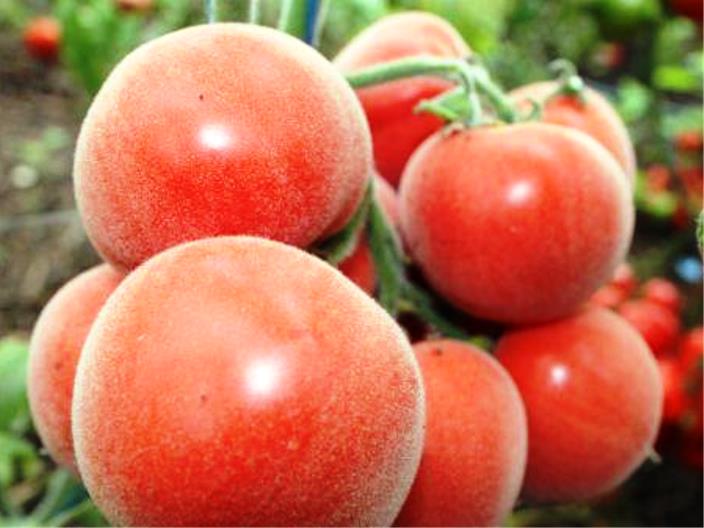 It is becoming more and more difficult to surprise gardeners every year. Looking at the most ordinary seed stores, we observe the widest variety of tomato varieties and hybrids. What is there just, it is sometimes simply impossible to choose a specific tomato.
It is becoming more and more difficult to surprise gardeners every year. Looking at the most ordinary seed stores, we observe the widest variety of tomato varieties and hybrids. What is there just, it is sometimes simply impossible to choose a specific tomato.
If you want to buy a productive, unusual, tasty and easy-to-grow variety at the same time, we recommend tomato to Velvet dude.
Content
Description and characteristics of tomato Velvet dude
Unfortunately, there is no exact information about by whom and when the variety was bred. The first reviews of the new product from gardeners from Russia appeared in 2014. Tomato Velvet dude ripens in the early stages, the first fruits are harvested 85-100 days after the seeds are hatching.
The variety has excellent immunity to diseases of the tomato and very steadily accepts all unpleasant surprises from the weather. In cities with a temperate or warm climate, tomato Dude is grown in unprotected soil. In cooler cities, it is recommended to plant it in greenhouses.
Characteristics of plants and fruits
The bush is determinant, standard, the first brush is formed over 5 or 6 sheets. The height of the plant in open and closed ground does not exceed 120 cm, usually up to 80 cm. They are covered with thick smoky-blue pubescent leaves of the potato type.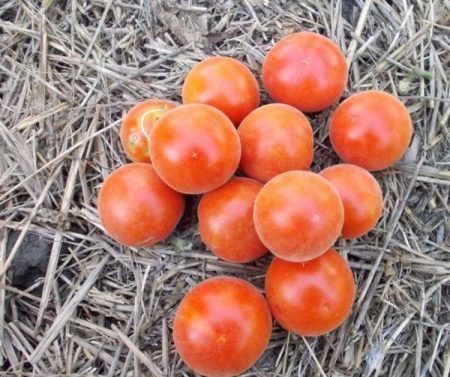
Fruits are pinkish-red, rounded or flat-round, uniform. The weight of a tomato ranges from 90 to 220 grams. The pubescent skin, like a peach, velvety plaque is poorly removed, but it does not interfere and does not cause discomfort when consumed. The pulp is tender and juicy, no more than 4 seed chambers, few seeds. The skin is soft, with overfilling or re-ripening of the fruit there is a risk of cracking.
Use and yield
Taste of tomato Velvet dude is unsurpassed, sweet with a slight acidity, the aroma is bright, tomato and fruit. The variety is good for fresh consumption, preservation, pickling, freezing and various processing in cooking.
No more than 5 fruits are tied in one brush; on average, up to 6 kilograms of tomatoes are harvested from one bush. For a determinant tomato, this is an excellent indicator. If we rely on the feedback of gardeners from different regions, we can conclude that the variety bears fruit equally well in different growing conditions.
Advantages and disadvantages of tomato Velvet dude
The dream of every grower is to find a tomato variety that is characterized only by good qualities and meets all the important selection criteria. Velvet dude is just such a tomato, it has no shortcomings, even true fans of traditional varieties and hybrids will definitely like it. Main advantages: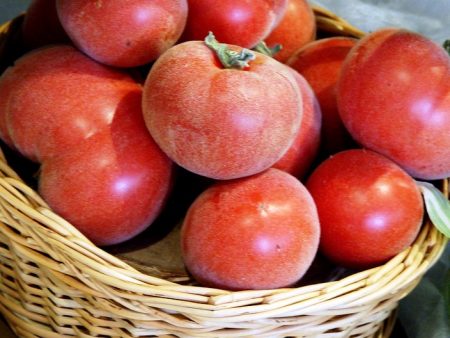
- the possibility of growing in all regions of Russia, in open and closed ground;
- good productivity in any conditions;
- universal use of tomato, excellent taste and marketability;
- seeds can be collected independently;
- disease resistance;
- the variety tolerates various weather changes;
- if you remove the fruits a little immature, they will easily tolerate transportation and lie down to 3 weeks.
It should be noted decorativeness of this tomato. The bush looks very beautiful - bright, peach-shaped tomatoes as if shrouded in silver-blue foliage.
Seedling and seed harvesting
Sowing is carried out from early March to the first half of April. Seedlings can be grown with picking and without.The soil should be prepared in advance, all components are collected in the fall and stored in a cool room. The main components:
- non-acid peat (2 parts);
- river or washed coarse sand (0, 5 parts);
- turf land (1 part);
- sifted wood ash (1 cup per bucket of mixture);
- humus or mature compost (1 part).
Garden land cannot be taken from places where nightshade crops grew last season. In the resulting mixture, you must add 10 grams of urea and potassium fertilizer, as well as 30 grams of superphosphate. The prepared soil 7 or 10 days before sowing should be sieved and calcined in the oven, add a little vermiculite, mix and moisten.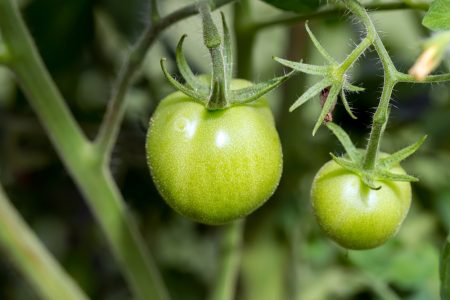
Seeds also need pre-sowing preparation, especially if they were harvested personally:
- grains are placed in a water-salt solution (tsp. salt in a glass of water), mix thoroughly and leave for 15 minutes. All emerging seeds are thrown away, and those that have sunk to the bottom are washed with clean water and dried;
- grains should now be pickled in a 1% potassium permanganate solution. Seeds are placed in a gauze bag and dipped in rose water for 20 minutes;
- The next step will be nutrition. Seeds can be processed in special shop preparations or use folk recipes (aloe or potato juices);
- germination will be the last procedure. The saucer is covered with a paper towel, moistened, and the seeds are laid out on the surface. It is necessary to ensure that the material does not dry out, while the grains should not be buried in water.
Hatching seeds are laid out on the surface of the soil, covered with a small layer of earth, and abundantly sprayed from the spray gun. The box is covered with polyethylene and put it in a warm place. When shoots appear, the shelter is removed and the seedlings are transferred to a warm room on a bright windowsill. At the stage of formation of 2 true leaves, seedlings dive in separate containers.
Watering is carried out often, moderately, drying out or waterlogging of the soil, at all stages of seedling growth should not be allowed. The first time the tomatoes are fertilized 14 days after the pick, the subsequent procedures are carried out every 15-20 days. It is better to purchase special fertilizer. On cloudy days, tomatoes need additional lighting. The seedlings are kept warm all the time, and 2 weeks before planting they begin to harden.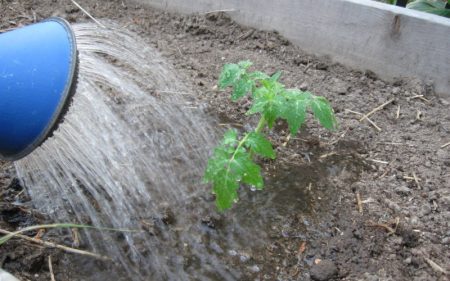
How to collect seeds correctly
You need to find the strongest bushes and mark the most beautiful and large tomatoes from the first brushes. It is desirable to pluck them in brown ripeness, it will be better if they do not ripen on the bushes, but at home on the windowsill. The seeds, along with the juice, are taken out, transferred to a jar, covered with a napkin and placed in a dark, warm place for fermentation.
As soon as a film appears on the surface of the contents, all mold and pop-up grains are discarded, and the rest are thoroughly washed with water. Seeds can be dried in any convenient way, but they should be stored only in paper or fabric bags.
Landing and Care Recommendations
Basically, velvet dude tomatoes are planted from mid-May to the end of June. On one square meter, no more than 4 bushes are placed. The plant is formed in 2 or 3 stems, the remaining stepsons are removed. The lower leaves should be gradually cut, and the upper ones can be left undisturbed, especially when tomatoes are grown in the open.
Support for garter should be installed before planting tomatoes. Pegs or trellises must be strong and stable. Watering is carried out 1 or 2 times a week, you need to use warm water. The first fertilizer is necessary 15 days after planting, subsequent every 14-25 days. You can alternate basal and foliar top dressing.For the former, organics and mineral complexes are used, and for the latter, a solution of boric acid (5 grams of powder per 5 liters of water).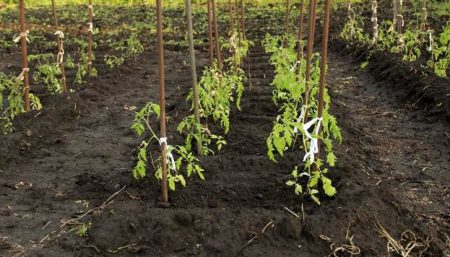
Watering can be combined with top dressing, moisten the earth and make fertilizers. Spraying is carried out before or after sunset. In particularly hot periods, the soil dries out very quickly so that the water does not evaporate the beds can be mulched. Weeding should be carried out frequently, weeds attract pests.
Tomato Velvet dude stands out against the background of other "velvet" varieties. For a short period of time, he managed to fall in love not only with collectors, but also with ordinary gardeners.
Reviews
Gennady. Recently I found information that Velvet dude is a mid-season variety, not true, it is early. We have been growing it for 3 years and we collect the first ripe fruits closer to mid-July. This tomato is not afraid of diseases, it also happened that the neighboring bushes of other varieties suffered from various ailments, and the dude always stood strong and healthy. Tomatoes are happy to eat fresh, close for the winter in salads, slices and make juices.
Vyacheslav. Velvet dude is one of my favorite varieties. I recommend it to anyone who wants to get a good harvest of delicious tomatoes. I do not spend any preventive spraying and in 2 years I have never seen any signs of disease. The care is standard, non-exhausting. I didn’t notice any pests either; next to tomatoes I always plant flowers and herbs with a strong aroma, and tansy and wormwood grow wildly behind the fence.




 Low-growing tomatoes, without pinching: 5 of the most delicious varieties
Low-growing tomatoes, without pinching: 5 of the most delicious varieties Why tomato seedlings grow poorly
Why tomato seedlings grow poorly We grow a tomato in a shell
We grow a tomato in a shell Growing tomatoes without watering according to the method of Kazarin
Growing tomatoes without watering according to the method of Kazarin